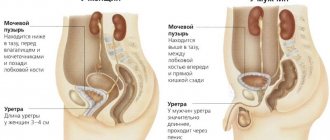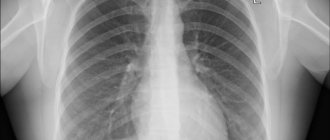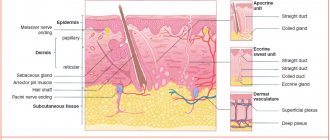A woman's uterus is an unpaired organ of the female reproductive system. It is where the fertilized egg develops. The uterus, in essence, is a container for the development and preservation of the fetus throughout the gestational period. The organ is characterized by physiological mobility. For example, it can change its position when the bladder is full or when the rectum is full. During pregnancy, as the fetus enlarges, the uterus rises.
Structure and structure
The uterus is located in the pelvis. The pear-shaped organ is located between the rectum and the bladder. It has three main parts:
- The cervix, which is the narrowed part of the uterus that connects to the vagina.
- Body with a cone-shaped cavity.
- The fundus, which is the upper convex part of the uterus, in the area of which the uterus communicates with the fallopian tubes.
The size of the uterus in women at different ages may differ. If necessary, standard indicators can be found on specialized medical websites.
- The walls of the uterus are three-layered. They consist of the following shells:
- Endometrium. This is the mucous membrane that covers the internal cavity of the organ. Its peculiarity is a large number of blood vessels. Its surface layer undergoes monthly changes and is shed naturally during the menstrual cycle. In this case, the deeper layer plays an important role in the restoration of the mucous membrane after the rejection of the surface layer during menstruation.
- Myometrium. This is a powerful muscle layer that provides good blood supply. Thanks to it, the necessary strong contraction of the uterus during childbirth is ensured. It is formed by a multilayer interweaving of bundles of smooth fibers in different directions. Between them there are layers of connective tissue and special elastic fibers.
- Perimetry. This is the serous outer connective tissue membrane.
What does a healthy uterus look like?
A woman's uterus is designed to preserve and support a developing baby. This is one of the most amazing organs in our body. The normal size of the uterus is about 7 cm in length and 5 cm in width at the top and 2.5 cm at the bottom.
Anatomically, the normal uterus consists of 3 layers:
- The perimeter is the outermost layer of the uterus; It is relatively thin compared to other layers.
- The myometrium is the middle layer. Within this myometrium are three layers of smooth muscle arranged as spiral, circular and longitudinal muscles.
- The endometrium is the inner mucous membrane. Contains excretory glands and is released in the form of bloody discharge during menstruation. Then it is restored due to the stimulating effect of the ovaries, which secrete sex hormones in phases.
Common anomalies
With congenital pathologies of fetal development, the uterus may be completely absent. But this anomaly, called aplasia, is extremely rare. Sometimes there is a small underdeveloped uterus with an irregular shape. The causes of the congenital anomaly have not been fully established, but it is believed that the anomaly occurs primarily due to exposure to infectious agents. The greatest risks exist when a pregnant woman becomes infected with bacteria or viruses in the first trimester. Aplasia can also be provoked by hormonal deficiency, which disrupts the formation of female genital organs.
Hypoplasia of the uterus is characterized by underdevelopment of the organ. In this case, its dimensions differ from the norm to a smaller extent. The main clinical signs of this anomaly are the late onset of menstruation, as well as their irregularity and pain. Treatment is possible using hormone therapy, physiotherapy and exercise therapy, but a positive prognosis depends on the degree of hypoplasia.
Also quite common is an anomaly, which is characterized by duplication of the uterus. This defect does not affect reproductive function. It is important that when pregnancy occurs, in this case, you are constantly under the supervision of a doctor to prevent premature termination of pregnancy.
Another common anomaly is the presence of an intrauterine septum. Because of this problem, menstrual cycle disorders often occur and the risk of uterine bleeding increases. During pregnancy, the likelihood of spontaneous miscarriages increases significantly, but infertility occurs in rare cases.
What Causes Uterine Disorders?
Let's consider external and internal influencing factors that can cause the uterus to malfunction and disrupt its function.
The womb is constantly working to provide the best environment for our developing baby. Since the menstrual cycle is a complex and well-coordinated mechanism of interaction between different organs of the reproductive and hormonal system, anything that damages the structure of a woman’s internal genital organs can cause disruption of the blood flow of the uterus and its normal functioning. Below are a few reasons and gynecological problems that prevent the uterus from being healthy.
Passive lifestyle
Leading a sedentary lifestyle without any physical activity creates a situation of stagnation of blood flow in the pelvis, uterus and other reproductive organs. The main artery that supplies blood to our legs also supplies blood to the uterus, ovaries and vagina. If we sit a lot, especially if we work at a desk, blood flow to our uterus can be impaired. This is also not a good situation if a woman has fertility problems associated with chronic inflammation of the appendages and adhesions.
Insufficient movement of organs in the abdominal cavity in conditions of lack of physical activity and regular dynamic loads can contribute to the progression of the adhesive process, especially if there are prerequisites for this.
A sedentary lifestyle also directly contributes to weakness of the muscles of the uterus and other intimate muscles.
Uterine fibroids
Fibroids can form in all layers of the uterus, causing mild to severe menstrual irregularity and/or pain; causing heavy menstrual bleeding, prolonged periods, pelvic pain or pressure, etc. Moreover, some women give birth with uterine fibroids, while others struggle with the problem of embryo implantation.
Although 20-60% of women over the age of 35 will develop uterine fibroids, gynecologists are actually not entirely sure what exactly causes them. However, they know that imbalances in estrogen and progesterone undoubtedly contribute to the growth of fibroids.
Scar tissue
Adhesions on the appendages and cicatricial constrictions (synechia) in the uterus can form for various reasons, which ultimately lead to injury to the endometrium and disruption of the uterus. Some of these reasons given by the reproductive endocrinology and infertility specialists at our Gynecology Clinic include:
- spontaneous miscarriage,
- curettage of the uterine cavity (abortion),
- caesarean section and manual separation of placenta,
- intrauterine device (IUD),
- abdominal surgery on or near the uterus,
- inflammatory diseases of the pelvic organs,
- sexually transmitted diseases and STIs,
- endometriosis.
Endometriosis
Internal endometriosis is when tissue in the lining of the uterus grows outside of its normal location in the uterine cavity. In women with endometriosis, these displaced tissues function and are influenced by hormones in the same way as normal endometrium. This means that they go through the same cycle as any endometrium - they bleed during menstruation. This atypical endometriotic tissue may attach to the ovaries, fallopian tubes, intestines, bladder, ligaments, or other areas of the abdomen. Very rarely, these cells attach to other areas of the body, including the lungs and nasal cavity.
Hormonal imbalance
Various hormonal imbalances contribute to or play a key role in various fertility problems. PCOS, uterine fibroids and endometriosis are just some of the most serious diagnoses that contribute to uterine dysfunction. If a woman's hormones are not balanced, her menstrual cycle is disrupted.
In case of irregular menstruation, there is a possibility that the uterus will not be able to completely empty its contents every month. A uterus that is not stimulated to secrete endometrium or that does not adequately secrete endometrium each month may atrophy. This means that the muscles lose their tone and strength. If the mucous membrane known as the endometrium (see photo above of what a healthy uterus looks like) is not stimulated for its monthly growth, then it does not form fully and cannot perform the task assigned to it by nature.
As mentioned earlier, the menstrual cycle is a complex symphony of interactions between internal and external factors of the body; anything that disrupts these communications or the anatomy of our reproductive system can cause the uterus to malfunction. These influencing factors include hormonal balance.
Uterine displacement
The normal position of the uterus should be straight up and down (vertical). In some cases, it may become excessively tilted back or forward, this is the so-called. "retroflexion of the uterus." This disorder may be a congenital condition, or caused by stretching of the supporting ligaments after childbirth, adhesions of the pelvic organs due to endometriosis, chronic adnexitis, or after surgical interventions in the pelvis.
An acquired malposition of the uterus with poor blood flow can cause women to experience symptoms such as pain, irregular periods, urinary tract infections, difficulty using tampons, as well as pain during intercourse and decreased frequency of orgasms or even no orgasms at all.
The danger of diseases and their treatment
Diseases of the uterus can disrupt the functioning of the female reproductive system and lead to infertility. Most pathologies are accompanied by pronounced and varied symptoms that cannot be ignored. Warning signs indicating problems with the uterus include pain in the lower abdomen and unpleasant vaginal discharge. Disruptions in the menstrual cycle and discomfort when urinating also often occur.
If they appear, you should urgently visit a gynecologist. Very often, most problems can be resolved quickly. To do this, you need to buy medications prescribed by your doctor at a pharmacy at an affordable price. They are now available in a huge variety. To save time, medications can be ordered in advance for delivery to the specified address.
During an inflammatory process in a woman’s uterus, the temperature often rises and severe intoxication is observed. To carry out treatment, you need to purchase anti-inflammatory drugs and undergo a course of therapy in accordance with the doctor’s recommendations. If this is not done, the disease becomes chronic, which is characterized by constant nagging pain in the lower abdomen. In addition, advanced inflammation threatens the development of infertility.
Oncological diseases are dangerous and life-threatening for women. Tumors can affect different parts of the organ. At the initial stage, cancer is asymptomatic. But only with early diagnosis and timely treatment is a positive prognosis possible. To do this, you must definitely visit a gynecologist for a preventive examination.
The development of various uterine pathologies is caused by various factors. First of all, these are infectious processes in the body. Diseases are also caused by hormonal imbalances and problems in the functioning of the endocrine system. The condition of the organ worsens with numerous abortions.
Diagnostics
At the first stage of diagnosing a bent uterus, a gynecological examination is performed to assess the clinical picture. The doctor assesses the degree of uterine bending and mobility of the reproductive organ. With a mobile form of retroflexion, the uterus can be returned to its typical position during a bimanual vaginal examination.
To determine the infection, a smear of vaginal flora is taken. Ultrasound and computed tomography are also prescribed if necessary. Histological analysis of the uterine cavity and hysterosalpingography, a technique for studying the patency of the fallopian tubes, are often indicated.
Hysterosalpingography
Endometrial hyperplasia
Let's consider one of the most common pathologies of the uterine cavity - endometrial hyperplasia.
Endometrial hyperplasia is a process characterized by inadequate and non-invasive proliferation (growth) of endometrial glands with varying quality of the underlying stroma. Recently, great importance in the development of this process has been attached to inadequate excessive growth of blood vessels, i.e. excessive angiogenesis. In the future, when creating drugs that can block these processes, i.e. have antiangiogenic properties, endometrial hyperplasia and treatment will be a very easy task for the doctor.








